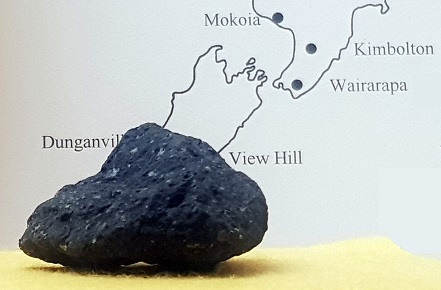
Of nine meteorites that have been found in New Zealand, only one (Mokioa, pictured above) was seen to fall, and that was way back in 1908. In 2004 a meteorite came through the roof of an Auckland house during daylight, but the fireball wasn’t seen.
Fireballs Aotearoa was established in February 2022 to change that. We use video cameras to watch the night sky for incoming meteorites and to calculate where the rock might be found.
The first RMS (Raspberry Meteor System) meteor cameras in NZ were built and run by Hamish Barker in Nelson and Jeremy Taylor in Motueka in 2021. In February 2022 Jim Rowe, a New Zealander who had co-founded the UK Fireball Alliance, visited Jeremy and Hamish and catalysed the formation of Fireballs Aotearoa by involving Professor James Scott of Otago University, Dr Michele Bannister and Professor Jack Baggaley of Canterbury University, the operators of the three existing CAMS meteor observation stations in the South Island and Bob Evans and John Drummond of the Royal Astronomical Society of New Zealand.
Michele came up with the “Fireballs Aotearoa” name, Jeremy created and published the website, James applied for funding, Bob bought a camera and Jim created the social media accounts. Janis Russell created our distinctive logo and banner, and we were up and running.
The first batch of ten RMS cameras was organised by Michele, who arranged for Jeremy to teach the Canterbury University rocketry club how to build them. From mid 2022 until mid 2023, dozens of cameras were built by James’s team at the Geology Department at Otago University. James very quickly built an RMS network which covered Otago and has been the driving force behind subsequent expansion of the network.
Initial funding for Canterbury’s cameras was provided by Jim, followed quickly by a “Curious Minds” grant that funded the initial Otago rollout and a large anonymous donation that allowed us to buy a big stock of camera parts. The project caught the attention of Eben Upton, chief executive of Raspberry Pi, who made sure that we could buy the necessary Raspberry Pi computers when they were otherwise unavailable in NZ in 2022 and 2023.
In 2023, Terry Richardson took over the building of camera systems for the rapidly-expanding network. We became a Section of the Royal Astronomical Society of New Zealand in October 2023.
As dozens of new camera operators have joined Fireballs Aotearoa, it has become a large, mutually-supportive and sustainable citizen science project. You are very welcome to join us.
By the way, here’s the roll-call that we plan to add to. In date order of find, NZ’s meteorites are:
| Year | Name | Region | Type | Finder |
| 1863 | Wairarapa | Wairarapa | Stony (chondrite) | W.H. Donald |
| 1879 | Makerewa | Southland | Stony (chondrite) | A. & I. Marshall |
| 1908 | Mokoia | Whanganui | Stony (carbonaceous chondrite) | W. Syme |
| 1925 | Morven | Canterbury | Stony (chondrite) | W. Stewart |
| 1953 | View Hill | Canterbury | Iron | C.G. Anderson |
| 1970 | Waingaromia | Gisborne | Iron | H. Reeves |
| 1976 | Dunganville | West Coast | Iron | Edwin (Ted) Dowie |
| 1976 | Kimbolton | Manawatū | Stony (chondrite) | R.H. de Rose |
| 2004 | Ellerslie | Auckland | Stony (chondrite) | B. & P. Archer |
Radio New Zealand had a short story on the Kimbolton meteorite discovery on Morning Report on 2022-03-09. The photo at the top of this page is of a cast of the Mokoia meteorite in Canterbury Museum.